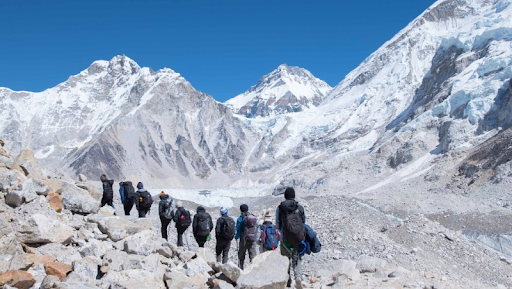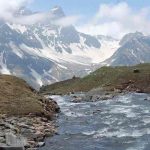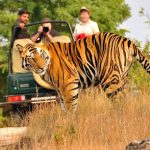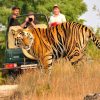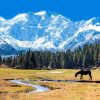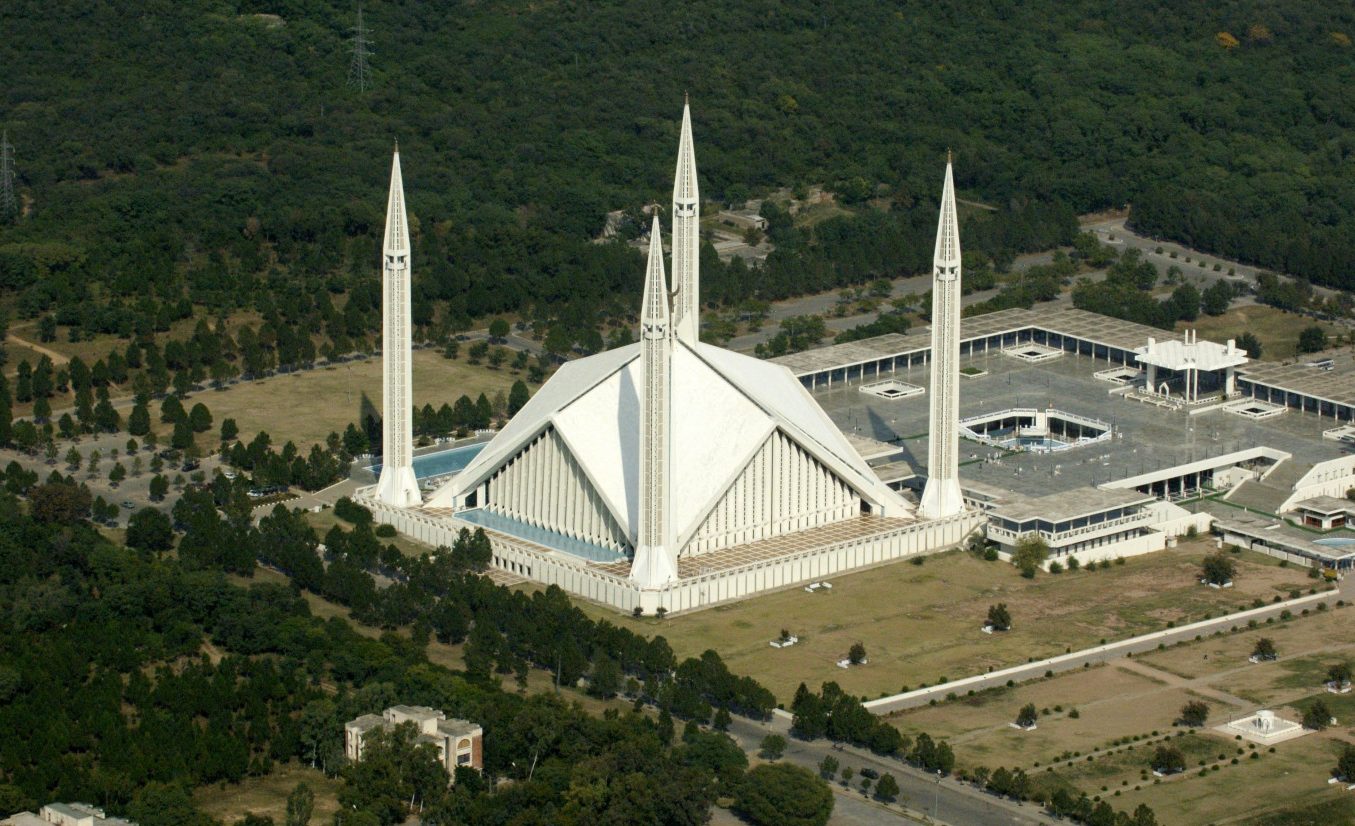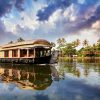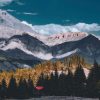The idea of conquering the altitudinous Everest which is a universally acknowledged mountain, has been a wish in the minds and hearts of many trekkers and hikers. Also popularly known as the “Stairway to Heaven,” Everest’s formidable peak offers a glorious outlook that makes it way superior to any other trek, thereby contributing towards making Everest one of the most strenuous ventures.
Everest Base Camp which is also attributed as ‘EBC’ has gained recognition as one of the most extraordinary adventures globally. Upon mentioning the Everest Base Camp Trek in Nepal a sense of thrill, adventure, and excitement is evoked among hikers worldwide. The trek acts as an entrance to the most uplifted summits of the world, which offers a very close encounter with the highest peak you can ever dream of.
A vibrant and attractive Sherpa culture can be witnessed during the trek and this will surely fill you with a sense of achievement and triumph when you get the chance to stand high at the mighty Mount Everest. Adventurers and trekkers from diverse backgrounds and nationalities come together to have this once-in-a-lifetime Himalayan experience.
The Everest Base Camp Trek stands out as perhaps the most recognized and appreciated trek in all of Asia, and also probably on a global level. The colossal popularity of the trek is always considered both a boon and a bane. However, the true beauty of the trek lies in the journey itself, as you ascend to witness the world from the peak of perfection.
Temperature Guide for the Trek
Since the Everest Base Camp stands high at an altitude of approximately 5,364 meters which is almost 17,598 feet, extreme and dramatic changes in the weather are observed during the year. Therefore, being well aware of the patterns of weather throughout the years as well as the fluctuations in temperature can immensely make your trekking experience enjoyable and great.
- January: The Chilliest Time of the Year
January is considered one of the most cold and chilly months here as this is the duration of middle winter in the region of Everest. For trekking during this month the trekkers need to gear up well with warm clothing, gloves, thermals, and caps. Finding a place to stay won’t be a big issue as during this time the accommodation options along the trail are less likely to be entirely booked due to the lack of crowds this month. At high elevations, snowfall does occur frequently which usually causes diversions in the trail and even trail closures.
Day Temperatures : 6°C (42.8°F), At Lower Altitudes
Night Temperatures: -20°C (-4°F)
Air Pressure: Cold and Dry Air, Effective Altitude may seem higher, pressure around 5500m or above
Monsoon Measurement: Winter Season, Not much Rainfall was observed, < 20mm
*Note: Even the Day Temperature falls when you move to higher altitudes.
- February: Winter’s Final Stretch
February can be a great month for planning a trekking trip to the Everest Base Camp regardless of the cold weather. This is an ideal month for a peaceful and serene trekking experience if you’re well prepared and geared up to hold up your shield of warm clothing and other stuff as your protection from the cold weather. During the middle of February, you can even catch hints of approaching spring. February marks the final stretch of winters in this region.
Day Temperatures : 8°C (46.4°F), At Lower Altitudes
Night Temperatures: -15°C (5°F)
Air Pressure: Cold and Dry Air, Effective Altitude may seem higher, pressure around 5500m or above
Monsoon Measurement: Spring Season Approaches, Not much Rainfall observed, < 30mm
*Note: At higher altitudes, even in the daytime the temperatures could be below freezing point.
- March: Spring’s Inception
If you are someone who would prefer a tranquil trek without any discernment in the views and a bit of chilly weather won’t be much of a concern for you then March would be the suitable season for you to visit the Everest Base Camp Trek. During this month the skies are generally observed to be clear which provides the trekkers with the chance to enjoy the mesmerizing views of the mighty Mount Everest. The region boasts its abundance of flora and fauna during this month as the hard snow begins to melt and flowers bloom bringing back a sense of liveliness and colors to the all-white surroundings.
Day Temperatures : -2°C to -8°C (28.4°F to 17.6°F), At Lower Altitudes
Night Temperatures: -12°C (10.4°F)
Air Pressure: The best Time for Trekking Trips is moist, and Warm Air, Effective Altitude may seem 5300m or less.
Monsoon Measurement: Little Increase in Rainfall, around 30 to 40mm
- April: Spring’s Zenith
The month of April is amongst the most popular months for trekking to the Everest Base Camp. The weather during this time remains moderate and stable but, you must be aware of the fact that the weather in the mountains cannot be trusted as it fluctuates quickly sometimes. During April one can encounter beautiful colors of nature with blooming flowers and vibrant rhododendrons.
Day Temperatures : -2°C to -10°C (28.4°F to 14°F)
Night Temperatures: -12°C (10.4°F)
Air Pressure: The best Time for Trekking Trips is moist, and Warm Air, Effective Altitude may seem 5300m or less.
Monsoon Measurement: Pre-Monsoon season, Increase in Rainfall, around 50 to 60mm
- May: Spring’s Finale
May is that time of the year when the skies stay clear during the mornings and then eventually get cloudy till the afternoon. One can witness the picturesque views of the Everest without strains in May too. Even though the weather stays clear it still cannot be trusted entirely and weather fluctuations are quite a usual occurrence at Everest and the chances of rainfall as well as snowfall increase during the termination of the month. The trails aren’t very crowded during this time as many expeditions culminated in April already.
Day Temperatures : -2°C to -5°C (28.4°F to 23°F)
Night Temperatures: -10°C (14°F)
Air Pressure: The best Time for Trekking Trips is moist, and Warm Air, Effective Altitude may seem 5300m or less.
Monsoon Measurement: Pre-Monsoon season, Increase in Rainfall, around 60 to 70mm
- June: Monsoon’s Arrival
In Nepal, with the arrival of June, there comes the season of monsoon too. During this course of time, it is a strenuous task to predict the weather of the Everest Region as it fluctuates subsequently.
The initial days of June can be called a better choice for trekking trips as the monsoon isn’t at its best during these days. But this clear weather doesn’t stay long as cloud covers, heavy rainfall and decline in visibility become common.
The trails of the trek could become dangerous to embark on with all the mud which makes it slippery. The only perks of trekking in June are that you get easy bookings in teahouses and you can spend time in solitude.
Day Temperatures : 2°C to -2°C (35.6°F to 28.4°F)
Night Temperatures: -8°C (17.6°F)
Air Pressure: Warm and Moist Weather, Interference of Cloudy Weather while acclimatization, Fluctuating Effective Altitude
Monsoon Measurement: Initial phase of the Monsoon season, Heavy Rainfall, often exceeding 140mm
- July: Monsoon’s Height
The Monsoon peaks in July in the Everest region. This month may not be among the best choices for planning a trekking trip and is often considered as the most unfavorable month for trekking here.
July records heavy showers from above which can even lead to the disruption of trails as they become muddy and slippery. Some areas even have a history of landslide occurrences during this heavy rainfall month.
The perks of trekking during July are that you get to witness the vibrant hues spread in nature that wash out and become more colorful and bloomy after rainfalls.
Day Temperatures : 2°C to -2°C (35.6°F to 28.4°F)
Night Temperatures: -8°C (17.6°F)
Air Pressure: Warm and Moist Weather, Interference of Cloudy Weather while acclimatization, Fluctuating Effective Altitude
Monsoon Measurement: Peak of the Monsoon season, Heavy Rainfall, often exceeding 200mm
- August: Monsoon’s Farewell
Now it’s time for the monsoon to pack its bags and leave quietly as August approaches. Now is the time that trekkers await since post-monsoon weather is the best way to gain trekking experience at the Everest Base Camp.
If you opt for August for trekking then you can enjoy clearer skies and lush green sceneries of the Fall season. However, you cannot be short on gearing up material for the trek and must ensure full preparation with warm clothing, suitable trekking shoes or boots, and physical fitness.
Day Temperatures : 1°C to -1°C (33.8°F to 30.2°F)
Night Temperatures: -7°C (19.4°F)
Air Pressure: Warm and Moist Weather, Interference of Cloudy Weather while acclimatization, Fluctuating Effective Altitude
Monsoon Measurement: Heavy Rainfall, mostly around 180 to 200mm
- September: Peak Season Commencement
The Autumn season commences and the region becomes an overly popular spot for trekking trips. During this time the weather stabilizes as the season of monsoon finally ends for good.
The visibility is enhanced during September which is a huge plus point for trekkers. There are no signs of pollution and dust after rainfalls and the region blooms in vibrant hues.
The skies of this month are as clear as crystals boosting the view of the summits. This month marks the beginning of the peak season for trekking and the trails get crowded. In September it is always advisable to make your accommodation bookings before avoid the hassle. Gear up well with essentials and safety equipment and embark on your trekking trip to the Everest Base Camp Trek.
Day Temperatures : 10°C to 15°C (50°F to 59°F)
Night Temperatures: -1°C to -5°C (30.2°F to 23°F)
Air Pressure: Stable but Dry Weather, Effective Altitude around 5300m
Monsoon Measurement: Rainfall subsequently decreases, averaging around 100 to 120mm
- October: Peak Season’s Zenith
October is marked as the most popular month to embark on the Everest Base Camp Trek. The weather is just ideal with not much rain, clearer skies, and neutral temperatures.
All these factors combined make the month of October the fittest for trekking. The views of the mountains during this month are stunning and the visibility increases subsequently.
You could face issues in bookings for accommodations at the last minute but if you plan your trek well you may avoid the hassle and flow with smoothly happening events. You must ensure that you gear up well with safety gear and necessary items to be carried.
Day Temperatures : 12°C to 16°C (53.6°F to 60.8°F)
Night Temperatures: -6°C to -10°C (21.2°F to 14°F)
Air Pressure: Stable but Dry Weather, Effective Altitude around 5300m
Monsoon Measurement: Post-Monsoon weather, Raindrops observed, around 60mm
- November: Early Winter’s Touch
It’s the time of the month when winter starts approaching the trails. This time is still considered fit and fine for trekking during the initial days of the month. The weather remains stabilized with clear skies and a hint of greenery.
The spectacular scenes of the snow-capped mountains with a backdrop of clear blue skies are too peaceful to absorb and keep in your memories forever.
Snowfall can be observed at higher elevations with the progress of the month. The landscape then adds in itself a pristine white blanket of snow too beautiful to look at.
Day Temperatures : 6°C to 10°C (42.8°F to 50°F)
Night Temperatures: -10°C to -14°C (14°F to 6.8°F)
Air Pressure: Stable but Dry Weather, Effective Altitude around 5300m
Monsoon Measurement: Less to No Rainfall, around 20mm
- December: Winter’s Depth
In this month the winter fully arrives in the Everest Region. The weather conditions now become challenging, however, the trekkers who have experience in trekking and hiking can manage it without much difficulty.
The region receives an ample amount of snowfall which adds to a stage of complexity to the already complex Everest Base Camp Trek. But, this too can be conquered with determination and physical fitness. The layers of snow on the trails enhance the pious view of the area.
Day Temperatures : -5°C to 5°C (23°F to 41°F)
Night Temperatures: -15°C to -20°C (-5°F to -4°F)
Air Pressure: The Air turns Cold and Dry, Effective Altitude Higher (similar to that of January and February)
Monsoon Measurement: Dry month, Less to No Rainfall, <20mm
Conclusion
Ultimately, the Everest Base Camp trek is more than just a trek—it’s an odyssey of self-discovery, perseverance, awe-inspiring beauty, and a transformative experience that leaves an indelible mark on the soul.
Throughout the trek, every step is a testament to the human spirit’s resilience and determination. From the stunning beauty and occasional obstacles of the monsoon season in July to the pleasant temperatures and unobstructed skies in September, trekkers have the flexibility to mold their adventure according to their individual preferences.
It’s a journey that challenges, inspires, and ignites a passion for adventure. As trekkers descend back to civilization, they carry with them not only memories of the majestic Himalayas but also a newfound appreciation for the resilience of the human spirit and the wonders of the natural world.
Frequently Asked Questions
When is the optimal time for trekking to Everest Base Camp?
The ideal months for embarking on a trek to Everest Base Camp generally fall within the pre-monsoon period (February to May) and post-monsoon season (late September to December). These periods are characterized by clearer skies and relatively moderate temperatures.
What are the typical temperatures at Everest Base Camp?
During the winter months (December to February), temperatures at Everest Base Camp can plummet below -20°C. Throughout the trekking season, which spans from March to May and September to November, nighttime temperatures can still dip below freezing.
Does the monsoon season bring significant rainfall to the Everest Base Camp trek?
Indeed, the monsoon season (June to early September) is known for its heavy rainfall and frequent cloud cover. These weather conditions pose additional challenges during the trek and can make scenic views less predictable.
Can we trek to the Everest Base Camp during the monsoon season?
While it’s possible to trek during the monsoon season it is generally less advisory and uncommon. Due to heavy rainfall, there are issues such as potential flight disruptions and decreased visibility. Choosing for trekking apart from these months is usually preferred.
How quickly does the weather fluctuate along the Everest Base Camp Trek?
The weather conditions do fluctuate a lot along the Everest region and cannot be trusted to be stable apart from some particular months. The weather conditions shift rapidly due to the high elevation and rugged landscape. It’s not surprising here to encounter rainfall, snowfall, and then sunshine all within a single day.
Do all tea houses along the trail of the Everest Base Camp provide heating facilities with accommodations?
Most tea houses feature a communal area which is generally equipped with a stove for warming-up and heating purposes, but individual bedrooms typically lack heating. Given the immensely cold nighttime temperatures, it is crucial to have a high-quality sleeping bag for warmth and comfort.

